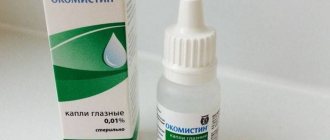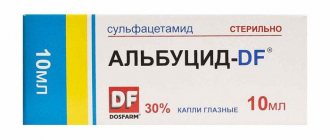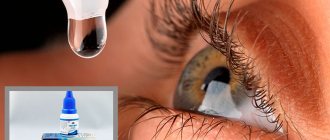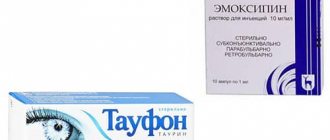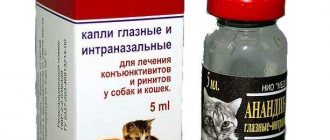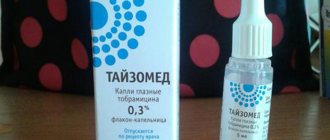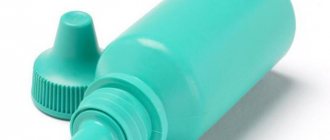Indications for use
For the treatment of inflammatory processes of the visual apparatus and some ear diseases, Norfloxacin is available in the form of drops. One bottle contains a clear, colorless or slightly greenish liquid intended for topical use. Bottle volume - 5 ml. It comes with a dropper attachment for more comfortable use.
As long as the product is kept in an airtight container, it can be stored for 2 years. After opening the bottle, the drops are allowed to be used for no more than 10 days.
To treat inflammatory processes affecting the organs of vision, adhere to the following treatment regimen:
- If the symptoms are severe, it is necessary to drip 1-2 drops of the drug into each eye every 20-30 minutes. When the symptoms subside, the procedure is performed less frequently - 4-5 times a day. It is recommended to use Norfloxacin for 2 days even after all symptoms have disappeared.
- For moderate symptoms, Norfloxacin is used every 4-12 hours.
- For trachoma (chlamydial eye damage) 3-4 times a day for 1-2 months.
If the symptoms disappear, norfloxacin drops are used for another 2 days to finally consolidate the result.
Norfloxacin eye drops – instructions, analogues, reviews and price
Norfloxacin is a solution of drops for the eyes and ears with an antibacterial effect. In ophthalmology it is used to treat superficial eye infections (bacterial conjunctivitis, blepharitis, keratitis).
Composition and release form
Norfloxacin is a solution of eye drops 0.3%, transparent, colorless, sometimes slightly greenish, contains:
- Active substance: norfloxacin – 3 mg;
- Auxiliary components: decamethoxin, sodium chloride, disodium edetate, buffer solution, water.
Packaging: white plastic dropper bottles of 5 ml in a cardboard pack.
Pharmacological properties
Norfloxacin is an antimicrobial drug of the fluoroquinolone group. Its action is based on suppressing the activity of DNA gyrases in bacterial cells and bacterial DNA replication. The wide spectrum of antimicrobial action that the drug has extends to gram-positive and gram-negative microorganisms: Klebsiella spp.
, Escherichia coli, Proteus spp., Enterobacter spp., Citrobacter spp., Acinetobacter spp., Serratia spp., Providencia spp., Pseudomonas aeruginosa, Neisseria gonorrhoeae., Haemophilus influenzae., Neisseria meningitidis., Salmonella and Schigella, Campylobacter.
Enterococcus and Acinetobacter are insensitive to the action of the drug, anaerobic bacteria are not sensitive at all.
The onset of action of the drug occurs in the first hour after its instillation. It is eliminated from the body to a greater extent by the kidneys, the half-life is 3 – 4 hours.
Indications for use
Norfloxacin eye drops are used to treat superficial infections of the eye (bacterial conjunctivitis, keratitis, blepharitis), if the pathogen is sensitive to this antibiotic.
Directions for use and doses
For acute infectious processes of the eye, the drug is prescribed conjunctivally, 1-2 drops with an interval of 15 to 30 minutes, then the frequency of instillations decreases.
In the treatment of moderately severe infectious processes, Norfloxacin solution is prescribed 2 to 6 times daily.
For the treatment of trachoma (acute and chronic), the drug is prescribed 2 drops 2 – 4 times daily, for up to 2 months.
After the symptoms of the infectious process disappear, it is recommended to continue using Norfloxacin solution for another 48 hours.
Contraindications
- Individual intolerance.
- Pregnancy, lactation.
- Age up to 15 years.
Norfloxacin drops should be prescribed with caution to patients with epilepsy, convulsive syndrome of any etiology, cerebral atherosclerosis, severe impairment of liver or kidney function.
Side effects
After instillation of Norfloxacin solution, local allergic reactions are possible, accompanied by a burning sensation, pain, hyperemia and swelling of the conjunctiva, and photophobia.
Overdose
No cases of overdose have been described.
If the solution is accidentally ingested, nausea, vomiting, diarrhea, dizziness and headache may occur. Sometimes there is a feeling of anxiety.
Treatment of overdose is symptomatic (large amounts of fluid and “acidification” of urine to prevent the occurrence of crystalluria).
Drug interactions
No interactions with other drugs have been identified with topical use of Norfloxacin solution.
special instructions
Norfloxacin drop solution is intended for topical use only. The best therapeutic effect of eye drops is achieved with systemic antimicrobial therapy (with the exception of mild cases).
To avoid the development of symptoms of photophobia, during treatment with the drug it is recommended to wear tinted glasses and avoid prolonged exposure to bright light.
The drug can cause a short-term change in visual perception, which seriously complicates driving vehicles and working with moving mechanisms.
Store Norfloxacin solution away from exposure to sunlight at room temperature. Not given to children. Shelf life – 2 years. After opening the bottle, the shelf life of the solution does not exceed 10 days.
Price of the drug Norfloxacin
The cost of the drug “Norfloxacin eye drops” in Moscow pharmacies starts from 85 rubles.
Analogs Norfloxacin
| Tobradex | Garazon | Maxitrol | Tsipromed |
By contacting the Moscow Eye Clinic, you will be able to undergo an examination using the most modern diagnostic equipment, and based on its results, receive individual recommendations from leading specialists on the treatment of identified pathologies.
The clinic is open seven days a week, seven days a week, from 9 a.m. to 9 p.m. You can make an appointment and ask the specialists all your questions by calling a multi-line phone (free for mobile phones and regions of the Russian Federation) or online using the appropriate form on the website.
Make an appointment with an ophthalmologist
Fill out the form and get a 15% discount on diagnostics!
Source: https://mgkl.ru/patient/aptechka/norfloksatsin
Who are eye drops recommended for?
Norfloxacin is a representative of the so-called broad-spectrum antibiotics. This is a universal drug that copes with any bacteria.
Typically, such medications are used in cases where there is no time left to identify the pathogen, since the disease is rapidly progressing. They are also prescribed in the presence of extensive infections.
Medicines containing broad-spectrum antibiotics are appropriate for:
- pathogen resistance to other antibiotics;
- the presence of an infection caused simultaneously by several bacteria;
- as preventive measures after surgical procedures to prevent possible complications.
Norfloxacin eye drops help fight:
- conjunctivitis and keratoconjunctivitis;
- blepharitis and blepharoconjunctivitis;
- keratitis;
- dacryocystitis;
- trachoma;
- ulcerative lesions of the cornea;
- inflammation of the meibomian glands (meibomitis).
Norfloxacin is also prescribed to people who have had a foreign body removed from their eye.
Norfloxacin is often prescribed after surgery.
Therapeutic effect of drops
The main component of the medicine is the substance norfloxacin, which contains 3 mg in 1 ml of solution. Auxiliary components are presented:
Thanks to the effect of the drug, the doubling of the hereditary material of pathogenic microorganisms is blocked, as a result of which their reproduction stops and they die.
The antibiotic Norfloxacin is active against gram-positive and gram-negative bacteria:
- enterococci;
- staphylococci;
- streptococci;
- enterobacteria;
- Escherichia;
- Klebsiella;
- pseudomonas;
- Proteus;
- salmonella;
- shigella;
- Yersinia.
The medicine is resistant to enzymes secreted by pathogenic microorganisms, which makes the drug more active for treatment.
When the drops are used topically, the effect of the drug begins within one hour. The accumulation of the drug continues for 2 days, after which its concentration reaches a maximum.
https://medglaza.ru/aptechka/kapli/norfloksatsin-instruktsiya.html
Special instructions and interactions with other drugs
Norfloxacin in liquid form is used only topically. If you combine eye drops and systemic antimicrobial therapy in the form of oral tablets, you can achieve maximum effect.
It has been noted that as a result of prolonged and uncontrolled use of Norfloxacin, microorganisms may lose susceptibility to it, which will lead to an increase in their number . Therefore, it is recommended to use Norfloxacin as prescribed by a doctor, with strict adherence to the course of treatment.
It is necessary to use the drops as carefully as possible when:
- epilepsy;
- convulsive syndromes of non-epileptic origin;
- severe renal/liver disorders;
- atherosclerotic lesions of cerebral vessels.
After using Norfloxacin, it is advisable to refrain from driving for half an hour and from work that requires increased attention.
If the simultaneous use of eye drops with other local ophthalmic drugs is planned, it is better to take a 15-minute break between procedures.
When Norfloxacin is combined with Warfarin, the anticoagulant (anti-blood clotting) effect of the latter is enhanced. A sharp decrease in blood pressure cannot be ruled out if the drug is taken with antihypertensive drugs. With the simultaneous use of an antibiotic and drugs from the nitrofuran group, the effect of taking the latter is reduced.
Norfloxacin eye drops ear
active ingredient: norfloxacin;
1 ml norfloxacin 3 mg (0.003 g)
excipients: sodium chloride, decamethoxin, trilon B (trilon B), buffer solution (pH 4.67), purified water.
Pharmacological group
Means used in ophthalmology and otology. Antimicrobial agents. Norfloxacin.
ATC code S03A A.
Indications
Superficial eye infections (bacterial conjunctivitis, keratitis, blepharitis), infections of the outer and middle ear (external otitis, chronic purulent otitis media).
Adverse reactions
From the organ of vision: feeling of discomfort, sensation of a foreign body, swelling of the eyelids, hyperemia and swelling of the conjunctiva, photophobia.
Allergic reactions: rash, itching, Quincke's edema, dermatitis.
On the part of the hearing organs: itching in the ear, ringing in the ears.
Others: unpleasant taste in the mouth.
Children
Not prescribed to children under 15 years of age.
Features of application
Norfloxacin in the form of drops is prescribed for topical use only. To achieve the best therapeutic effect, drops should be used in combination with systemic antimicrobial therapy (except for mild cases).
Severe and sometimes fatal cases of hypersensitivity reactions (anaphylactic reactions) have been reported in patients receiving systemic quinolines, some patients after the first dose.
Some reactions were accompanied by cardiovascular collapse, loss of consciousness, tingling, swelling of the throat or face, dyspnea, urticaria, and itching. Only a few patients had a history of hypersensitivity reactions.
Severe anaphylactic reactions require immediate emergency treatment with epinephrine and other resuscitation measures, including oxygen therapy, infusions, antihistamines, corticosteroids, amines, vasoconstriction, and artificial ventilation as clinically indicated.
Long-term use of norfloxacin, like any other antibacterial drugs, can lead to increased growth of microorganisms that are insensitive to it, including fungi. If superinfection occurs, appropriate treatment is recommended.
Norfloxacin drops should be prescribed with caution to patients with epilepsy, convulsive syndromes of other etiologies, with severe liver/kidney dysfunction, and with cerebral atherosclerosis.
Photophobia may develop; Wear sunglasses and avoid prolonged exposure to bright light.
You should stop using Norfloxacin at the first sign of skin rash or other signs of a hypersensitivity reaction.
Regardless of the severity of clinical manifestations, treatment of ophthalmological diseases should be carried out after a thorough examination of the eyes using a slit lamp.
When using the drug for the treatment of otitis, it is recommended to carry out medical examinations of patients to timely determine the possible need for other therapeutic measures (systemic use of antibiotics, surgery, etc.).
Before instilling the drug into the ear, it is necessary to aspirate the pus and rinse the external auditory canal with an antiseptic solution.
The ability to influence the reaction rate when driving vehicles or other mechanisms
For 30 minutes after instilling the drug into the eyes, you should refrain from driving vehicles and engaging in potentially hazardous activities that require increased attention.
Interaction with other drugs and other types of interactions
Interaction with other drugs with topical use of norfloxacin has not been described.
However, there is evidence that systemic use of some quinolones leads to an increase in plasma theophylline concentrations, affects the metabolism of caffeine and enhances the effect of oral anticoagulants such as warfarin and its derivatives, and is also associated with a temporary increase in serum creatinine levels in patients who cyclosporine was used together.
Basic physical and chemical properties
transparent, colorless or slightly greenish liquid.
Storage conditions
Store at a temperature not exceeding 25 ° C in the original packaging.
Keep out of the reach of children.
The shelf life of the solution after opening the bottle is 10 days.
Package
5 ml in a bottle with a dropper cap.
Manufacturer
LLC “Experimental Plant” GNTsLS “, Ukraine
Pharmex Group LLC, Ukraine
Location
Ukraine, 61057, Kharkov, st. Vorobyova, 8.
(LLC “Experimental plant” GNTsLS “).
Ukraine, 08300, Kiev region, Boryspil, st. Shevchenko, 100
(Pharmex Group LLC).
Source: https://www.medcentre24.ru/medicamenty/norfloksacin-kapli-glaznye-ushnye.html
Analogues of this drug
When a medicine is not suitable for a patient for certain reasons, a specialist will definitely select analogues of the drug, which may include both expensive medicines and more affordable ones.
You can replace Norfloxacin with the following drugs:
- Tobrex. Eye drops with an antibiotic from the aminoglycoside group, which has a bactericidal and bacteriostatic effect. Effectively copes with most pathogens for inflammation of the organs of vision.
- Vigadex. Contains an antibiotic from the fluoroquinolone group.
- Nettatsina. It contains a semisynthetic antibiotic of the aminoglycoside group - netilmicin. The drug can be used from 3 years of age.
- Dex-Gentamicin. A combined eye product that has antibacterial, anti-inflammatory and anti-allergenic effects. Before use, you must familiarize yourself with the contraindications, since Dex-Gentamicin is prohibited for some eye pathologies.
- Ciprofloxacin. It is produced in the form of drops and tablets and has the same effect as Norfloxacin. Among its advantages is its low price, but an imported drug will cost more.
Side effects
An antibiotic may cause side effects. Such reactions include:
- dyspeptic disorders;
- allergy;
- dizziness;
- headache.
See also
Instructions for use of Prevalin spray for children and adults, analogues of the drug
Read
If these reactions occur, stop taking the drug. In this case, consultation with a specialist is necessary.
Features of the use of the drug
Before using eye drops, you should wash your hands thoroughly with soap and water. If the patient has crusts or purulent discharge in the eye area, they will need to be removed first.
After administering the drops to the eyes, doctors advise the patient to refrain from driving for half an hour. It is necessary to stop wearing lenses during treatment.
To make manipulation more convenient, the patient should lie on his back or simply tilt his head.
During pregnancy and breastfeeding
The annotation for the drug states that Norfloxacin is one of the drugs that are prohibited for use during pregnancy and breastfeeding. This prohibition is explained by the fact that the placenta is not a barrier to the absorption of antibiotics from the fluoroquinol group, so the child may suffer.
However, pregnancy and lactation are not an absolute contraindication. The drug can be prescribed in case of emergency, if the benefit from it exceeds the possible harm to the baby. When an antibiotic is prescribed for a woman who is breastfeeding, the child should be switched to formula.
Prescription of the product for children under 15 years of age
Patients over 15 years of age can take the medicine. However, there are often reviews of the use of Norfloxacin in younger children. The main thing is not to use the product without the doctor's permission.
Instructions for use of Norfloxacin
The method of administration and dosage of the drug depend on the dosage form of Norfloxacin.
Pills
The tablets are intended for internal use.
It is recommended to take the medicine on an empty stomach or during meals with plenty of liquid.
You can take the tablets once a day, at the same time of day. However, it is best to take the drug twice – in the morning and in the evening.
The dosage and course of therapy are prescribed by a specialist, depending on the severity of the pathology, as well as the individual characteristics of the patient.
Drops
The drops are intended for instillation into the eyes and ears.
The dosage depends on the severity of the disease:
- For acute eye infections, two drops are prescribed in each eye every half hour. Then the frequency of instillation is reduced.
- Typically, for eye diseases, it is necessary to instill eye drops up to six times a day, 1-2 drops.
- To treat ear diseases, 5 drops should be instilled into the ear canals three times a day.
If the symptoms of the disease disappear, it is recommended to use the drug for another 2 days.
Features of use for children
In childhood, tablets should not be taken.
Norfloxacin drops are not prescribed to children under 15 years of age.
Use for pregnant women and breastfeeding
The period of pregnancy is a contraindication for the use of Norfloxacin.
Due to the property of the active substance to penetrate into breast milk, it is not recommended to use the drug for nursing mothers.
If treatment with the drug is necessary, breastfeeding should be stopped. The use of drops during this period may be prescribed by a doctor if the benefit to the woman is higher than the risk to the fetus.
Use in renal or liver failure
In case of liver and kidney failure, use the drug with caution. The specialist can adjust the dosage.
Treatment with tablets should be carried out under medical supervision.
Overdose and side effects
When using Norfloxacin drops, some patients may complain of negative symptoms, which may be accompanied by:
- skin rashes;
- Quincke's edema;
- increased sensitivity to sunlight;
- itchy sensations;
- burning;
- swelling;
- discomfort in the eye.
Sometimes, during treatment with Norfloxacin, exudative erythema appears, which is characterized by the formation of a specific rash (red spots) on the skin and mucous membranes.
Also in severe cases of individual hypersensitivity, the following may occur:
- bitterness in the mouth;
- nausea;
- heartburn;
- abdominal pain;
- dizziness;
- anxiety.
In medical practice, there are no cases associated with an overdose of Norfloxacin when applied topically.
Photophobia (photophobia) may develop during therapy. Wearing sunglasses is recommended.
If taking Norfloxacin is accompanied by skin rashes or other negative manifestations indicating excessive sensitivity to the components, treatment should be stopped and the doctor should be informed.
Sometimes a significant increase in the concentration of a substance (with combined local and general use) inside the body, due to non-compliance with the rules of use, results in anaphylactic shock or Quincke's edema.
Norfloxacin
Norfloxacin is a broad-spectrum antibacterial drug. Its scope of application covers a large number of different infectious diseases: infections of the genitourinary system (cystitis, pyelonephritis, urethritis, prostatitis), gastrointestinal diseases (salmonellosis). Norfloxacin in the form of eye and ear drops is used in otorhinolaryngology and ophthalmology.
pharmachologic effect
Norfloxacin preparations exhibit bactericidal activity by blocking bacterial DNA replication, thereby suppressing their reproduction and destroying them.
The antibiotic acts on the following groups and types of gram-negative and gram-positive bacteria: enterococci, staphylococci, streptococci, enterobacteria, Escherichia, Klebsiella, pseudomonas, Proteus, Salmonella, Shigella, Yersinia. It is also active against pseudomonads, Vibrio cholerae, and ureaplasma.
Norfloxacin is resistant to the action of beta-lactamases, microbial enzymes that can destroy the antibacterial agent. The drug is inactive against the causative agent of syphilis (treponema) and is able to hide the symptoms of the disease when used.
This should be taken into account when making a diagnosis and prescribing treatment. The dosage form in the form of drops for topical use allows you to use the antibacterial agent directly at the site of the lesion and achieve the best treatment result.
When using eye and ear drops, their effect begins after 1 hour and reaches its maximum concentration after two days. The product is well distributed in the genitourinary organs, which allows it to successfully treat diseases of this system.
(Norfloxacin is one of the best drugs for cystitis, prostatitis and other diseases).
Processing and elimination of the drug is carried out by the liver and kidneys.
Contraindications
Norfloxacin drops and its analogues are contraindicated in children under 15 years of age.
There is no data on the use of eye and ear drops in pregnant and breastfeeding women, however, they should not be used in these cases either, since fluoroquinolone antibiotics can pass through the placenta, penetrate into breast milk, cause joint damage in pregnant women and negatively affect child. Norfloxacin may be taken by pregnant women only if it is absolutely necessary for treatment and the risk is justified. It is recommended to stop breastfeeding while using the drops.
Norfloxacin should be used with caution in cases of epilepsy, atherosclerotic cerebral vascular disease, and impaired liver or kidney function.
Warning when using the drug in patients with epilepsy and convulsive syndromes of other etiologies is based on the fact that Norfloxacin does not combine well with anticonvulsants. Also, you should not use the drug if you are hypersensitive to it.
If signs of an allergy to an antibiotic appear, you should immediately stop taking it and consult a doctor. Do not use Norfloxacin if there is a non-bacterial infection (viral or fungal).
Side effect
When using eye drops, allergic reactions may occur: skin rashes, Quincke's edema, increased sensitivity to sunlight, itching, burning, swelling and discomfort in the eye. Reviews also contain reports of exudative erythema and various rashes after using the medicine.
Side effects of ear drops may include ringing and noise in the ears. In addition, in some cases there may be an unpleasant taste in the mouth.
In some cases, when used topically, bitterness in the mouth, nausea, heartburn, abdominal pain, dizziness and anxiety are observed.
When using an analogue of the drug, Ciprofloxacin, a slight decrease in visual acuity and the appearance of infiltration on the cornea of the eye are possible.
Overdose
No overdose phenomena have been reported with the use of Norfloxacin drops. When using the drug orally, nausea, vomiting, headache, dizziness, and diarrhea are possible.
There is no antidote for Norfloxacin, so treatment of drug overdose involves symptomatic therapy.
In some cases, an overdose due to non-compliance with the instructions for use can lead to complications such as anaphylactic shock or Quincke's edema. In this case, resuscitation may be required to eliminate the phenomena.
Interaction with other drugs
No reactions were observed with the combined use of Norfloxacin eye drops and other drugs. However, when taking systemic antibacterial agents of the fluoroquinolone series together with warfarin, an increase in the effect of the latter was observed. If Norfloxacin is used together with nitrofuran, it worsens its effect.
Special instructions and precautions
The drug is intended for topical use only, do not take drops orally. Also, as a precaution, it is necessary to refrain from driving and other activities that require concentration for half an hour.
When using eye drops, it is recommended to wear sunglasses and avoid sunbathing during treatment. When using the analogue of Norfloxacin - Ciprofloxacin, you should stop wearing contact lenses. If any phenomena of hypersensitivity to sunlight occur, you must stop taking the drug.
Before instilling drops into the ear canal, it is necessary to clean the ear canal of pus and inflammatory exudate. It is recommended to use Norfloxacin drops in conjunction with systemic antibacterial drugs taken orally (orally) or by injection.
In addition, before taking the medicine, you must definitely visit a doctor, since uncontrolled and long-term use of antibacterial drugs leads to a decrease in the sensitivity of the pathogen to the therapy and, as a result, a lack of therapeutic effect. Also, with long-term use of Norfloxacin, accelerated growth of fungi of the genus Candida begins.
The shelf life of Norfloxacin drops is 2 years if it is sealed in a dark place, inaccessible to small children, at room temperature. After opening the package, the drops must be consumed within 10 days.
Price
The average cost of Norfloxacin ear and eye drops in pharmacies is about 170-200 rubles. Reviews about the drug and its possible substitutes, as well as their prices, can be found on the Proglaza.ru portal. The product has quite a few substitutes, similar in action and composition, but the main ones will be: Normax, Norflox, Floxal.
The main active ingredient in the analogues will also be Norfloxacin. Another drug with a similar effect, also belonging to the group of fluoroquinolones, is Ciprofloxacin. It is sold in both eye drop and tablet form. Ciprofloxacin is suitable for killing many types of bacteria, including those against which other antibiotics were powerless.
Its advantage over other drugs is its low cost: the price of a domestic drug is about 20 rubles, Ciprofloxacin from foreign manufacturers will be slightly more expensive.
In general, Norfloxacin has positive reviews, it shows good results in the treatment of ophthalmic and ENT infections, it is affordable, it can be bought at any pharmacy where it is dispensed with a doctor’s prescription.
Mode of application
In ophthalmology, for the treatment of acute eye infections, it is necessary to instill 2 drops of the drug into the eyes quite often (about every half hour). In the future, when the inflammatory phenomena subside a little, the frequency of administration should be gradually reduced.
For mild inflammation, Norfloxacin eye drops should be used up to six times a day. The course of treatment for acute processes is no more than five days. For the treatment of trachoma, the frequency of use of drops is 4 times a day for 1 month.
It is recommended that after the symptoms of the disease disappear, do not stop taking the drug, but continue for another two days.
For ear diseases, the instructions for use advise instilling five drops into the ear canal three times a day.
In order for the drug to be as effective as possible, it should be used in a horizontal position, lying on your side or with your head tilted to one side.
After administration, it is recommended to remain in this position for two minutes. For greater comfort, Norfloxacin drops should be warmed to body temperature before use.
The method of using Ciprofloxacin will be similar. Before use, it is recommended to first undergo an examination and consult a doctor to make an accurate diagnosis and identify indications and contraindications for taking Norfloxacin.
There are known cases of allergic reactions (urticaria, anaphylactic shock, Quincke's edema) and even death with uncontrolled use of the drug. In addition, with a viral and fungal etiology (cause) of the disease, an antibacterial agent is simply useless, since it does not affect these types of pathogens of the infectious process.
Also, with long-term use of Norfloxacin, the growth of fungi of the genus Candida accelerates, which provokes the development of candidiasis, which is quite difficult to treat.
Release form
Norfloxacin tablets
In stock
Analogs (7)
Where to treat
Source: https://proglaza.ru/drugs/kapli/norfloksatsin-e.html
Contraindications to use of the product
Be sure to carefully read the instructions for the drug. The antibiotic Norfloxacin, prescribed to effectively eliminate eye diseases, has contraindications that should not be ignored. The medicine is allowed to be used by patients over 15 years of age.
The list of patients for whom Norfloxacin is not recommended includes those who suffer from individual intolerance to the components of the drug.
Relative contraindications are:
- epilepsy and convulsive syndromes of other origins;
- cerebral atherosclerosis;
- liver and kidney disorders.
It is important to exercise special care when using Norfloxacin simultaneously with drugs prescribed for seizures, since they have low compatibility rates.
As for women carrying a child and breastfeeding, the use of Norfloxacin is possible only if the risk is justified and the drug is prescribed by the attending physician.
Reviews on the use of antibiotic eye drops
Patients have different opinions about the results of treatment with Norfloxacin. Many are pleased with the inexpensive cost of the drug and the small volume of the bottle, since after opening the package you can use the antibiotic for a maximum of 10 days. This volume is quite enough for one course.
Despite the fact that the use of the medicine is allowed only from the age of 15, young mothers use it as prescribed by a doctor for their young children.
In general, reviews about the use of the drug are positive. If patients followed medical recommendations exactly and did not exceed dosages, improvement occurred in a short period.
Among the negative aspects that are occasionally noticed by those who have used Norfloxacin, it is worth noting a burning sensation after instilling eye drops and the presence of an insufficiently comfortable tip.
In some cases, patients buy Norfloxacin for nasal instillation, and they feel better.
The antimicrobial drug Norfloxacin, which copes well with many bacteria, will be most effective if patients seek help in time and strictly follow medical instructions.
Tablets - how to use
Orally: for cystitis without complications - 400 mg twice a day for 7 - 10 days; for infectious diseases of the urinary tract - within 3-7 days; for chronic recurrent urinary tract infections - up to 12 weeks.
For acute bacterial gastroenteritis - 5 days; for pharyngitis, cervicitis, proctitis, acute gonococcal urethritis - 800 mg once; for typhoid fever - 400 mg of the drug three times a day for 14 days.
As a prophylactic agent: against sepsis - 400 mg twice a day; against bacterial gastroenteritis - 400 mg once a day; against travelers' diarrhea - 400 mg of the drug the day before departure and throughout the trip (no more than 21 days); against relapses of infectious diseases of the urinary system - 200 mg of Norfloxacin per day.
In patients with impaired renal function with CC greater than 20 ml per minute, no dosage adjustment is required.
Patients on hemodialysis, as well as those with CC less than 20 ml per minute (or serum creatinine levels above 5 mg per 100 ml), are prescribed half the therapeutic dose twice a day or the full dose once a day.
Indications for the use of Norfloxacin, reviews of use
"Norfloxacin" has a bactericidal and antimicrobial effect against some gram-positive bacteria and most gram-negative bacteria. According to reviews, the drug is effective for diseases of the urinary tract (pyelonephritis, cystitis, urethritis), shigellosis, salmonellosis, cervicitis, prostatitis, endometritis, gonorrhea. It is prescribed as a preventive measure for the recurrence of urinary tract infections, bacterial infections in granulocytopenia, and “travelers’ diarrhea.” Externally, "Norfloxacin" is used for corneal ulcers, keratitis, conjunctivitis, keratoconjunctivitis, blepharitis, for the prevention of eye infections after removal of a foreign body, infectious complications after surgical operations on the hearing organs, for chronic and acute otitis media.
Analogues of “Norfloxacin”: “Nolitsin”, “Lokson-400”, “Sofazin”, “Norilet”, “Norfatsin”, “Norbaktin”.
How Simply Recommends Why the medicine doesn’t work The key to successful treatment is, of course, following all the doctor’s recommendations and informing him of all significant changes during therapy. However, a specialist can talk as much as he wants about the regimen and duration of taking the drug, but most patients will still violate these rules. Read more
According to reviews, Norfloxacin sometimes causes problems with the digestive system. Diarrhea, heartburn, bitterness in the mouth, decreased appetite, abdominal pain, vomiting, and nausea appear. "Norfloxacin" can cause crystalluria, glomerulonephritis, dysuria, polyuria, albuminuria, urethral bleeding, headache, insomnia, arrhythmia, dizziness, tachycardia, fainting, decreased blood pressure, hallucinations, candidiasis, allergic reactions (skin itching, swelling, urticaria) .
